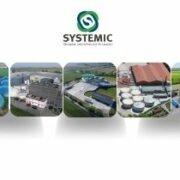Lessons learnt from five large-scale demonstration plants
Five large biogas plants participating in SYSTEMIC project as demonstration plants, have constructed innovative nutrient recovery and recycling (NRR) installations and developed new business cases over the course of the project. The five biogas plants convert biowaste, animal manure and sewage sludge into valuable organic and mineral fertilising products. Though they each operate under unique conditions, there are similarities in the barriers that they have faced and the key factors that have turned their innovation into a success. They now share their experiences and give recommendations for followers.
The five biogas plants invested in innovative digestate treatment systems including evaporators, reverse osmosis and nitrogen stripping and phosphorus recovery. Realisation of technical innovations was not without setbacks. Three of the demonstration plants that had to engineer and construct their installation during the time span of the project faced delays during engineering, construction or commissioning of the technical installations. A shortage of skilled engineers and a lack of materials were mentioned as bottlenecks. Subsidies, for example through involvement in this H2020 project, were found to be helpful to control financial risks. The project therefore not only contributed to the realisation of NRR technologies at the biogas plants but, indirectly also contributed to the learning process of local engineering companies preparing them for future installations to be built.
Development of innovations in digestate treatment also involves product- and market development which is a key component of a successful business model. A success story is the sale of fully biodegradable mulch mats, pots and paper produced by demonstration plant BENAS (Bremen, Germany). The biogas plants is equipped with a FibrePlus installation which includes an ammonia stripping unit followed by separation of organic fibres which are thereafter further processed into paper and carton products. The FibrePlus installation was already in use at the start of the SYSTEMIC project but it took several years to bring the product to the market. They initially targeted industrial companies whom were interested in purchasing the fibres as a commodity for fibre board production, but would not pay enough to create a positive business case. Benas then realised that their fibres – being fully biodegradable and from organic origin – have unique selling point and that this could open up the way to niche markets but only if they would be able to convert the raw material into market-ready end-products. They are now proud to be producer of the first FiBL-certified[1] mulch paper being marketed under the name MagaVerde targeting application in organic vineyards. The development process of BENAS shows similarities with the ongoing development process at Groot Zevert Vergisting (Beltrum, The Netherlands) which is producing a low-P soil improver from the solid fraction of digestate. They are exploring opportunities to apply this fibrous product as a peat-replacer in potting soil which would create far greater profit as compared to the sale as a soil improver to local farmers.
Production of tailor-made fertilising products is another key factor for creating revenues out of fertilisers. Waterleau New Energy (Ieper, Belgium), for example, is producing a dried solid fraction out of digestate which they now blend with evaporator concentrate to a 50% dry matter organic fertiliser. This avoids formation of dust and the fertiliser has a higher market value because of the increased N and K content. The solid fertiliser is transported to France because there is no demand for this type of fertilizer in the region where the plant operates.
Groot Zevert Vergisting, operating in a region with a surplus of animal manure, processes digestate into a solid fraction and an RO concentrate. They are now selling a tailor-made fertiliser, consisting of a blend of RO concentrate, liquid urea and ammonium sulphate, that meets criteria of farmers with respect to the N content and nutrient ratio’s. The blend is sold at a price similar to that of synthetic N fertiliser. The revenues however, do not outweigh the costs for product analysis, storage, transport and low-emission injection of the fertiliser. High costs for product handling are related to the low N content (0.8%) of the RO concentrate and hence it’s large volume. Nevertheless, the plant owner benefits from the investment in the reverse osmosis installation since they can now sell their fertiliser to farmers in the region whereas they previously had to export the digestate over long distances. These benefits arise from the fact that the RO concentrate complies with criteria for RENURE (REcovered Nitrogen from manURE) fertilisers and can therefore be applied as an alternative for synthetic fertiliser on top of the limit of 170 kg N/ha for animal manure. This is an great example of an equal level playing field for biobased versus synthetic fertilisers but yet an exception since others still experience price differences or difficulties in getting there fertiliser accepted abroad.
While innovations in digestate treatment and product marketing are generally long-lasting, market conditions which may change relatively fast. An example is the decrease in gate fees and supply of animal manure at Groot Zevert Vergisting due to a decrease in the number of animals within the Netherlands. Hence, biogas plants need to have a certain level of flexibility to prevent being overtaken by changing market conditions or legislative criteria. This may also include flexibility in terms of energy production. A great example is Benas, which is acting as a so called grid stabilizer, converting biogas into electricity but only if there is a demand on the grid and otherwise storing biogas or converting it into green gas.
Overall, the innovations within they SYSTEMIC project would not have been succeeded without perseverance of the plant owners. Despite all the obstacles that had to be overcome, they do not regret their decision to invest in digestate treatment and nutrient recovery. Followers can benefit from these experiences and detailed information about the plant performances which are being shared on the SYSTEMIC website (www.systemicproject.eu).
[1] FiBL is the Research Institute of Organic Agriculture. An FiBL-certification allows use in organic farming




